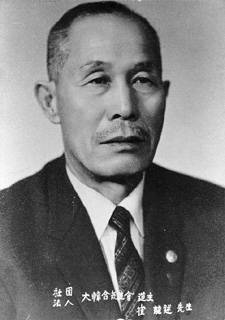HAPKIDO: THE ANTI-MARTIAL ART MARTIAL ART

Hapkido is culturally patterned Japanese aiki-jiu jitsu and by that, I certainly don't mean to demean either Hapkido or aiki-jiu jitsu. I mean it the same way that you might say that karate is culturally patterned Chinese kung fu.
To my mind, Hapkido is all aiki-jiu jitsu is and more, because it includes striking and kicking refined to a degree not found in any other art - whether Chinese, Korean or Japanese. However, many people are unaware of one aspect of this versatile art and that is: it was specifically modified to cope with other martial arts. By that I mean that many of its techniques work best when another martial artist is using classical techniques against the Hapkido practitioner.
The first student of Hapkido was a well-known Korean judoka by the name of Suh Bok Sup. One day, in the late forties, Suh saw the 'Father of Hapkido' Choi Yong Sool, in action and afterwards asked him about his fighting system. Choi explained that he was practicing 'hap ki yu sool', and Suh was so impressed by what he had seen that he asked Choi to teach him. Suh went on to become Choi's first black belt and helped the latter open his first school in Taegu City, Korea.
Suh was initially interested in learning how to adapt Choi's art so he could use it against judoka. This is an important point that is often missed, even though one of the first things a novice Hapkido student learns is defense against various holds. But look at some of the holds taught! They make little sense without the link to judo! Why, for example, are Hapkido students taught to defend against a grab made to the sleeve near the wrist? This is not likely to happen in the street though, along with grabs to the lapel, collar, armpit or shoulder, it would be used by a judoka attempting to throw you!
Defense against judokas was the first thing Suh wanted to use his hap ki yu sool against and that is why responses to judo grabs remain the first thing Hapkido novices learn today!
Hapkido is also uniquely structured to respond to sword attacks. Kumdo (the Korean rendering of 'kendo') was very popular in Korea after World War II and Suh decided he wanted his art to cope with that too. This is why modern hapkido contains a selection of techniques suitable for use against the stick ('dan bong') - techniques that were originally devised for use against the bamboo or oak sword.
Hapkido knife defense was developed because the carrying of guns by Koreans was outlawed, so knives were used a great deal by the criminal fraternity.
Defenses against kicks were incorporated to equip Hapkido practitioners to deal with students of tang soo do/kong soo do, kwon bop and later, TaeKwonDo. Interestingly, the earliest forms of these largely Japanese-influenced systems used only three kicks - the front kick, side kick and turning kick, so the earliest Hapkido defenses were designed to counter those. Later, of course, as the striking styles diverged from their karate ancestor, so the wealth of kicks increased.
In exactly the same way, defenses were developed to counter the Japanese- influenced standard lunge- and reverse punches, both of which leave the arms at full extension. Nowadays, of course, people don't fight like that. Punches are snapped back afterwards but, at the time when Hapkido defenses were being originated, TaeKwonDo players were taught always to lock their arms straight. There was no competition, so confrontations between striking styles took the form of prearranged sparring. Though prearranged, these duels were often quite bloody affairs as one academy sought to prove it could thrust its lunge punch through the opponent's block and on, into his face! Hapkido worked very well in such confrontations and the extended fist was avoided, grasped, harmonized with and destroyed!
Then Ji Han Jae looked at the way boxers throw punches and developed hapkido defenses to those too. This happened because Ji's Seoul dojang was right next to a boxing academy! If it hadn't been for that, Hapkido practitioners would still be trying to cope with jabs using defenses meant for locked-elbow punches.
I hope this short essay
on part of the historical development of Hapkido will lead to a deeper
understanding of the techniques used in today's Hapkido dojang.
.